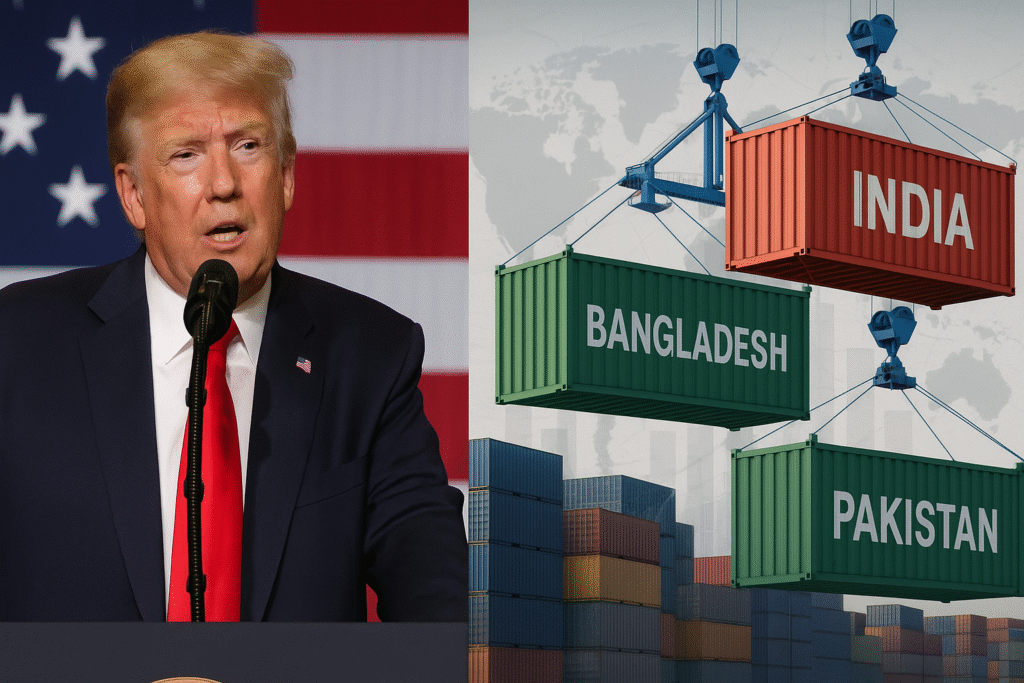Donald Trump Maintains 25% Tariff on India, Cuts Duties for Bangladesh and Pakistan
Washington D.C., August 1, 2025 – U.S. President Donald Trump, having returned to the White House following his victory in the 2024 elections, has reaffirmed his firm stance on trade tariffs against India. While maintaining a 25% tariff on Indian imports, Trump has announced a significant reduction in duties for Bangladesh and Pakistan, citing “strategic economic interests” and a push to rebalance trade deficits.
Why is Donald Trump Keeping a 25% Tariff on India?
Despite several trade negotiations and dialogues between the U.S. and India, Trump continues to label India as a “tariff king”, a term he popularized during his 2016 and 2020 campaigns. He claims India’s import duties on American goods are still “unreasonably high,” especially on automobiles, medical equipment, and agricultural products.
“India has taken advantage of the U.S. for too long. We need fair and reciprocal trade,” Trump said at a campaign rally in Ohio.
Tariff Cuts for Bangladesh and Pakistan: What’s the Strategy?
While India continues to face stiff duties, Trump’s trade team is looking to build better alliances with countries like Bangladesh and Pakistan.
Key Changes Announced:
- Tariff on textile imports from Bangladesh reduced from 18% to 10%
- Tariff on surgical and medical instruments from Pakistan slashed from 12% to 5%
Trump justified this move as a way to counterbalance China’s growing regional influence and to diversify sourcing away from dominant economies like India and China.
What Does This Mean for India?
Negative Impact on Indian Exporters
Indian businesses, especially those in apparel, pharmaceuticals, and engineering goods, may face increased pressure due to higher tariffs compared to regional competitors.
Ongoing Trade Tensions Under Trump’s 2025 Administration
India’s Ministry of Commerce has yet to issue an official statement, but analysts believe the move could trigger a diplomatic response or counter-measures under President Trump’s new administration, which began in January 2025..
Regional Reactions
Bangladesh Welcomes the Cut
Dhaka has praised the move, expecting a surge in garment exports to the U.S., which is its largest single export market.
Pakistan Sees it as Strategic Gain
Islamabad is optimistic that the lower duties will boost its exports and improve its struggling economy amidst IMF-led reforms.
Expert Opinion
Dr. Ravi Mehta, Senior Fellow at the Institute for Global Trade, commented:
“Trump’s tariff strategy is clearly more political than economic. It’s aimed at pressuring India while building influence in smaller South Asian countries.”
What Lies Ahead?
With President Trump now back in office following the 2024 U.S. elections, his trade policies are once again at the forefront of global attention. His recent decisions are expected to reshape global supply chains, and India’s response will be closely watched by international markets.
Conclusion
Trump’s decision to retain the 25% tariff on Indian goods while easing duties for Bangladesh and Pakistan sends a strong geopolitical message. With global trade dynamics rapidly evolving, India may need to rethink its export strategy and diplomatic channels to safeguard its interests.





